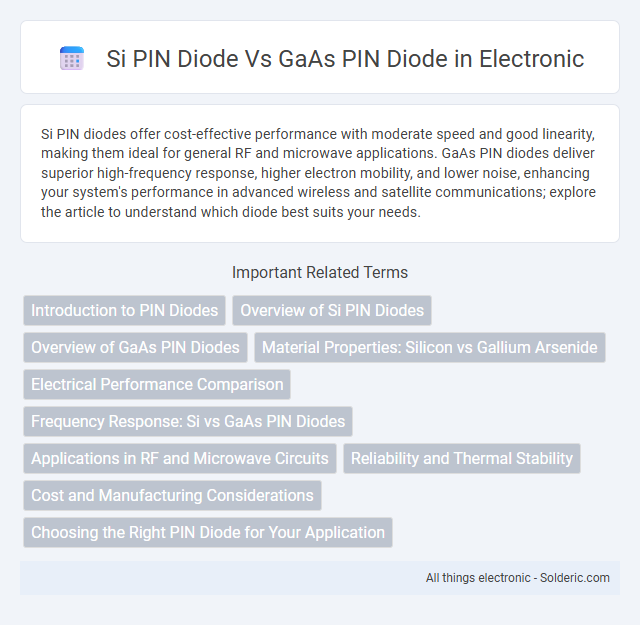Si PIN diodes offer cost-effective performance with moderate speed and good linearity, making them ideal for general RF and microwave applications. GaAs PIN diodes deliver superior high-frequency response, higher electron mobility, and lower noise, enhancing your system's performance in advanced wireless and satellite communications; explore the article to understand which diode best suits your needs.
Comparison Table
| Feature | Si PIN Diode | GaAs PIN Diode |
|---|---|---|
| Material | Silicon (Si) | Gallium Arsenide (GaAs) |
| Operating Frequency | Up to GHz range | Up to tens of GHz |
| Switching Speed | Moderate | High |
| Power Handling | High | Moderate |
| Noise Figure | Higher noise | Lower noise |
| Cost | Lower | Higher |
| Applications | Power control, RF switching, detectors | High-frequency RF and microwave circuits, mixers |
Introduction to PIN Diodes
PIN diodes are semiconductor devices with a layered structure consisting of P-type, Intrinsic, and N-type regions designed for high-frequency and switching applications. Silicon (Si) PIN diodes provide reliable performance with moderate switching speeds and low cost, making them suitable for general RF applications. Gallium Arsenide (GaAs) PIN diodes offer superior electron mobility and higher cut-off frequencies, enhancing your circuits' performance in microwave and millimeter-wave frequencies.
Overview of Si PIN Diodes
Silicon (Si) PIN diodes feature a wide intrinsic layer between the p-type and n-type regions, offering high-speed switching, low capacitance, and good linearity, making them ideal for RF and microwave applications. Their mature silicon fabrication technology enables cost-effective production with reliable performance in low to medium frequency ranges. Compared to Gallium Arsenide (GaAs) PIN diodes, Si PIN diodes provide better thermal stability and are more suitable for applications where your design requires robust, high-power handling with moderate frequency operation.
Overview of GaAs PIN Diodes
GaAs PIN diodes exhibit superior high-frequency performance, low noise, and high resistance to radiation compared to Si PIN diodes, making them ideal for microwave and RF applications. Their direct bandgap and higher electron mobility enable faster switching speeds and better signal integrity in high-speed communication systems. GaAs PIN diodes demonstrate enhanced linearity and power handling, which is crucial for advanced radar, satellite, and wireless communication technologies.
Material Properties: Silicon vs Gallium Arsenide
Silicon PIN diodes offer excellent thermal stability and cost-effectiveness due to silicon's abundant availability and well-established fabrication processes. Gallium Arsenide (GaAs) PIN diodes provide superior electron mobility and higher frequency performance, making them ideal for high-speed and microwave applications. Your choice depends on balancing silicon's reliability and affordability against GaAs's enhanced electrical properties for specialized uses.
Electrical Performance Comparison
Si PIN diodes exhibit lower series resistance and higher breakdown voltage compared to GaAs PIN diodes, making them suitable for high-voltage applications. GaAs PIN diodes offer superior switching speed and lower capacitance, which enhances performance in high-frequency and microwave circuits. Your choice depends on whether your priority is high-frequency operation or voltage tolerance.
Frequency Response: Si vs GaAs PIN Diodes
Si PIN diodes typically exhibit lower frequency response compared to GaAs PIN diodes due to silicon's material properties, which result in slower charge carrier mobility and longer carrier lifetimes. GaAs PIN diodes offer superior high-frequency performance, supporting microwave and millimeter-wave applications with reduced insertion loss and faster switching speeds. Choosing GaAs PIN diodes can enhance your circuit's efficiency in RF and high-frequency systems where rapid response is critical.
Applications in RF and Microwave Circuits
Si PIN diodes are widely used in RF and microwave circuits for signal switching, attenuation, and phase shifting due to their low cost and mature fabrication technology. GaAs PIN diodes offer superior performance in high-frequency applications with faster switching speeds and higher electron mobility, making them ideal for advanced radar, satellite, and high-frequency communication systems. Your choice between Si and GaAs PIN diodes should consider frequency requirements, insertion loss, and power handling capabilities specific to your application.
Reliability and Thermal Stability
Silicon (Si) PIN diodes exhibit superior thermal stability with a typical operating temperature range of -55degC to 150degC, maintaining consistent electrical characteristics under thermal stress. Gallium Arsenide (GaAs) PIN diodes offer higher frequency performance but have lower thermal conductivity, which can lead to reduced reliability under high-temperature conditions. The robust thermal performance of Si PIN diodes makes them preferable for applications requiring long-term reliability and stable operation in harsh thermal environments.
Cost and Manufacturing Considerations
Silicon (Si) PIN diodes are generally more cost-effective due to mature, large-scale manufacturing processes and abundant raw materials, resulting in lower production expenses compared to Gallium Arsenide (GaAs) PIN diodes. GaAs PIN diodes require more complex fabrication techniques and specialized equipment, causing higher manufacturing costs and limiting widespread availability. The choice between Si and GaAs PIN diodes often balances budget constraints with performance needs, as GaAs offers superior high-frequency characteristics but at a premium price.
Choosing the Right PIN Diode for Your Application
Silicon (Si) PIN diodes offer excellent performance in power handling and linearity, making them ideal for high-frequency switching and attenuation in RF circuits. Gallium Arsenide (GaAs) PIN diodes exhibit superior electron mobility and faster switching speeds, which enhance efficiency in microwave and millimeter-wave applications. Understanding the frequency range, power requirements, and switching speed of your device ensures the selection of the most suitable PIN diode for optimal performance.
Si PIN diode vs GaAs PIN diode Infographic

 solderic.com
solderic.com